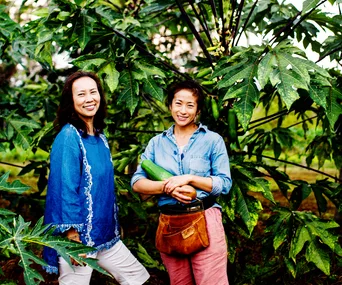Green chicken curry. Bánh mì. Laksa. You’d struggle to find many Australians who didn’t have at least some of these Southeast Asian foods on high rotation in their regular diet. But of course, it wasn’t always this way.
The first Chinese migrant to Australia was believed to be Mak Sai Ying, who arrived in the colony of NSW from Canton (now Guangdong) in 1818, followed by a wave of Chinese immigration in the mid-19th century as the gold rush gripped the nation. Thai and Japanese people began arriving in the early 20th century, though their numbers were suppressed by the White Australia Policy until the 1970s. That decade was also the time when Vietnamese refugees began to migrate to Australia, displaced by the Vietnam War. Malays, Indonesians, Koreans and others from Southeast Asia began to call Australia their home in various waves up to today.
All of them brought with them the cuisines and cooking customs of their homelands. One of the first commercial Chinese food items available to the broad population in Australia was tea. Cantonese immigrant Mei Quong Tart set up a popular tea house in Sydney in 1881 (though the snacks that accompanied his imported Chinese tea weren’t dumplings or noodles, but scones, cakes and sandwiches).
By the 1950s and 1960s, several Chinese-Australian recipe books, containing entries such as pineapple sweet and sour pork and chicken chow mein could be found in some non-Asian Australian homes. By the 1970s, you could buy Vietnamese bread and phở around Footscray and Springvale in Melbourne, and Sydney’s Cabramatta, while the 1980s and 1990s saw an explosion in both Japanese and Thai restaurants that were geared towards a curious western palate. Suddenly, everyone had a taste for Southeast Asian cuisine, from sushi to pad Thai.
Of course from the outset, each of these diasporas set up Southeast Asian food restaurants that were geared towards serving food to those who knew and loved it best: each other.

Palisa Anderson at Boon Luck Farm
(Photo: Kara Rosenlund)“Before she opened up her own restaurants, my mother [Amonrat “Amy” Chanta] worked in one of the earliest Thai restaurants to open up in Cammeray, called U-Thong,” recalls chef and restaurateur Palisa Anderson from Sydney’s Chat Thai. “On her days off, she pretty much wouldn’t eat anything else [but Southeast Asian food] so on Sundays we’d all visit each other and eat at each other’s restaurants.” Anderson and her family would eat fishballs, wontons and yen ta fo — pink noodles — with squid cooked in lime, from a Thai-Chinese restaurant in Sydney’s Dixon Street. Or larb and offal soups from an Isaan/Lao restaurant in Eastlakes.
As a kid growing up in Perth in the 1990s, chef and owner DJ Lee from rock and roll bánh mì outlet Le Vietnam travelled to Vietnam regularly with his family, which is where they’d get the majority of their Vietnamese food fix. He also laughs when he remembers the “weird” Vietnamese food he brough to school in his lunchbox. “The other kids were having ham and cheese sandwiches and I had spring rolls!” he says.
There were Vietnamese restaurants in Perth, particularly around the Northbridge area, but in those days Lee says he found the quality of the ingredients would often be low, as the proprietors were forced to keep their prices down thanks to Australians’ misguided belief that Southeast Asian cuisine should always be cheap.
When Lee opened his bánh mì business in 2014, he originally stuck to the same formula, only charging around $6 for his gourmet bánh mì. But once his rolls, made with creative twists like Japanese wagyu, lamb shanks or short ribs braised for 24 hours, started to take hold, he began to raise his prices as he realised that customers were starting to appreciate the value for money in what he was offering. And the response was as enthusiastic as ever. “We’re now selling 800 to 1000 rolls a day and it’s not slowing down,” says Lee.

Bánh mì at Le Vietnam.
Palisa Anderson’s Chat Thai stands out from other Thai restaurants in Sydney for a slightly different reason, though. Like Lee, her cooking has a strong focus on high-quality ingredients, including fresh seasonal vegetables from her own organic Boon Luck Farm. Her menu offers plenty of the popular Thai dishes that most non-Thai Australians would be familiar with like pad see ew rice noodles, green curry and Massaman curry, but she and her team love nothing more than adding fast and fresh specials that may not be as familiar to western palates, usually made with whatever is growing out of the ground that week. At the time of writing, she was preparing a special with freshly harvested bamboo shoots and is contemplating a dried jelly vine curry. “It’s fun,” she says. “We could do the same stuff day in, day out, but this keeps it interesting.”
In all its forms — traditional, boundary-pushing, westernised or a mix of all three — Southeast Asian food is now a beloved bedrock of Australian cuisine.
Discover more Southeast Asian food via Uber Eats.


